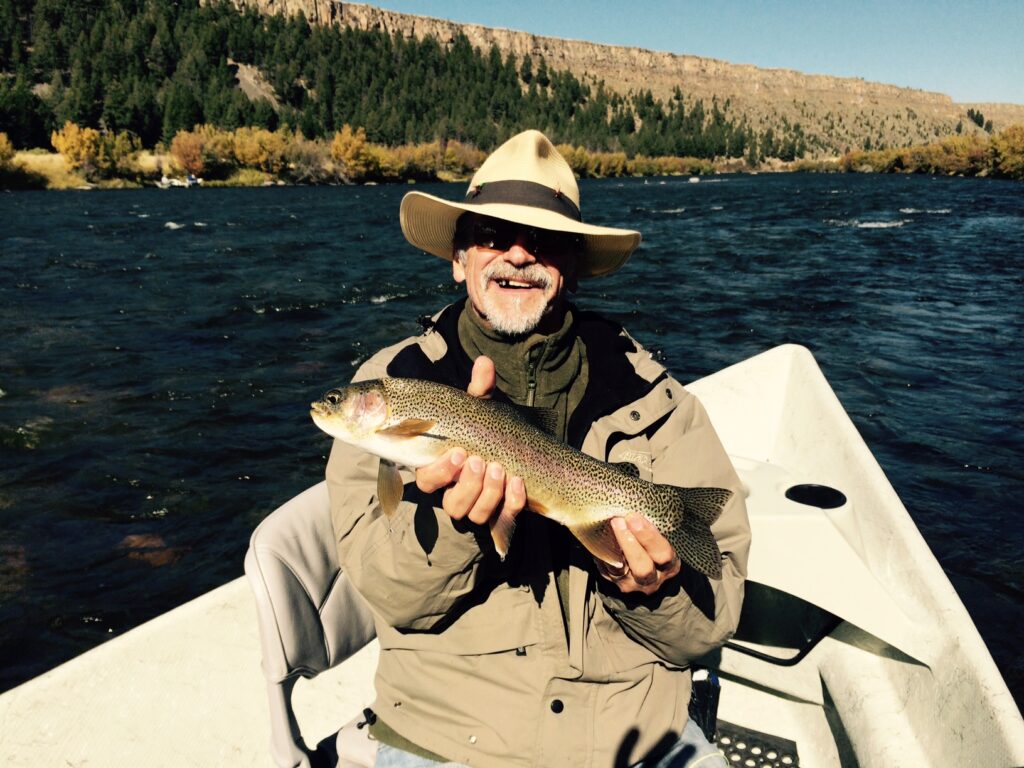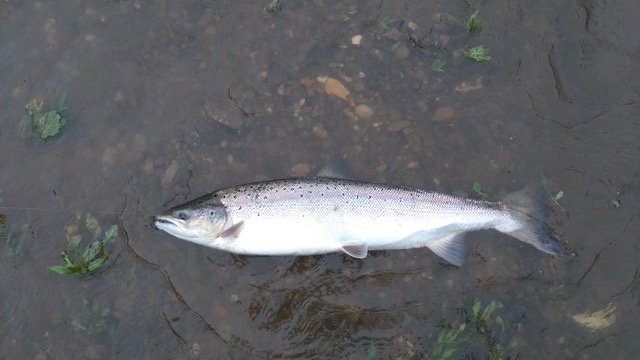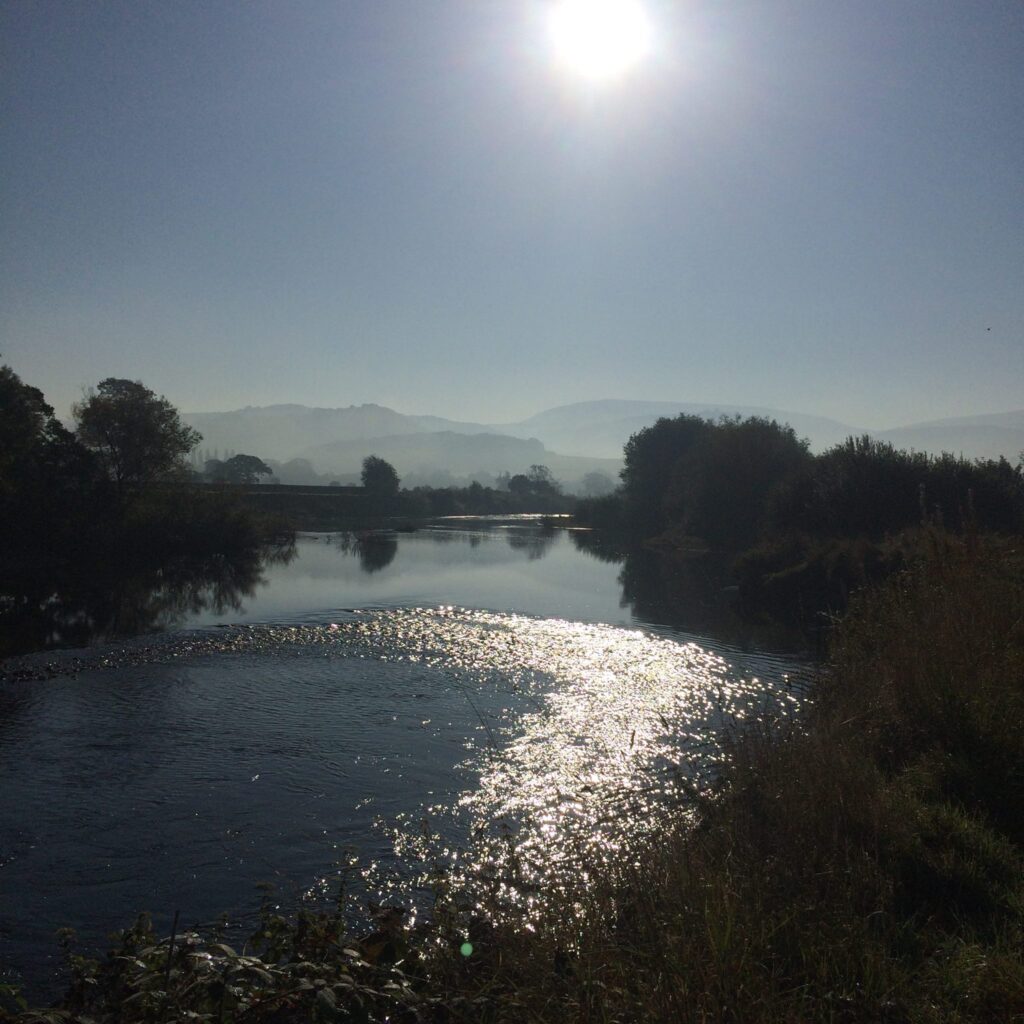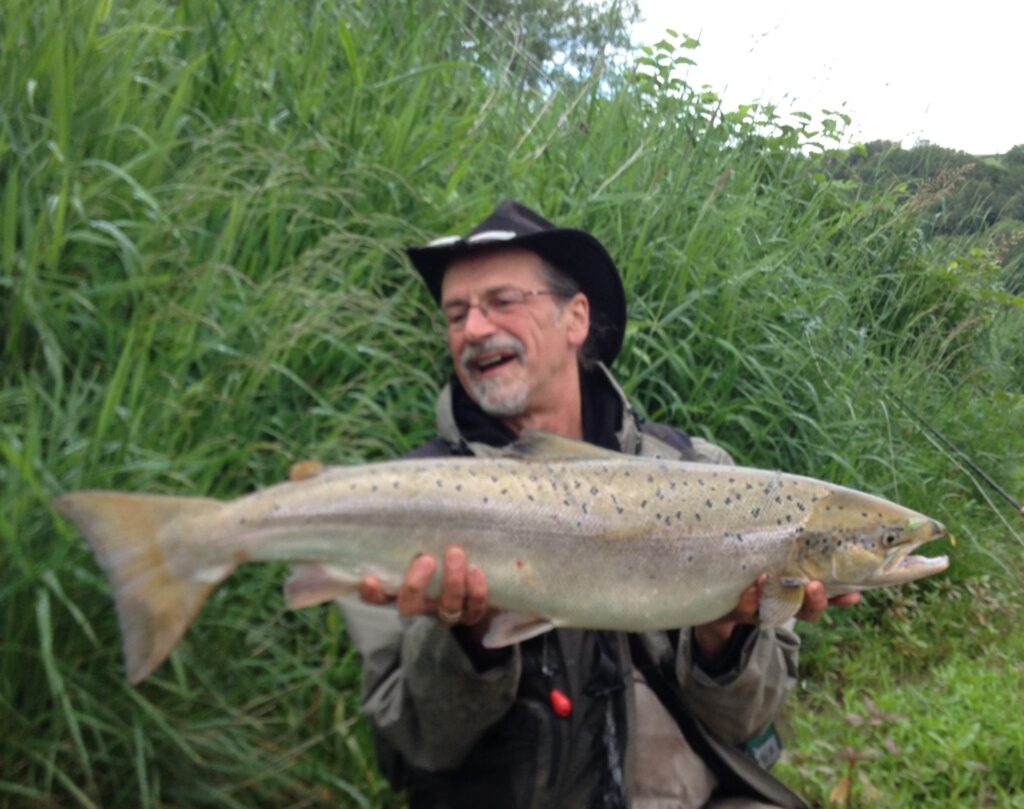This film was funded by a company called Patagonia, named for a region of South America famous for the best sea-trout rivers in the world. The movie presents a powerful case for closing hatcheries and shutting fish farms in the belief that the genetic integrity of hatchery fish is harmed in the process which, when you look at the bigger picture, is rather ironic.
Those Patagonian sea-trout were not indigenous to the region and were introduced from the UK. As were all the brown trout in New Zealand, Australia, the Himalayas, the USA and Canada. They got to those countries and thrived due to… hatcheries! There is no such thing as a wild sea trout in those countries: all came from hatchery-reared fish eggs.
Many of our UK salmon-rivers were wiped out during the industrial revolution and some (nowhere near enough) now have a few salmon returning to them. But ask yourself, where did they come from? There is only one way that happens. Fish straying from other rivers are repopulating them. The way that Nature repopulates a river is via salmon straying and finding themselves in the ‘wrong’ river, where it interbreeds with any wild fish in that river and so spreads its genes. This happens in salmon rivers all the time and is how Nature strengthens a genetic pool. I’m told salmon returning to the River Mersey were found to have genes from over 30 rivers. This alone casts doubt on any ‘genetic integrity’ argument against hatcheries harming a gene-pool.

Another example was the work of the hatchery on the Tyne which has repopulated a dead river and now it’s probably the best salmon-river in England. See Peter Greys excellent book on the subject ‘Swimming Against the Tide’ which demonstrates that hatcheries do work very well when properly managed.
Our own River Wye, until recently arguably the finest salmon river in Europe with a run of fish in the tens of thousands, a couple of years ago shut down its only salmon hatchery due to people in ‘authority’ (EA, NRW, WUF etc.) acting upon the kind of misinformation published in this film. It saves them a lot of money to NOT run a hatchery and when challenged they can point to ‘the science’ as their excuse. They should be reminded that it wasn’t so long ago that science determined phrenology to be a legitimate discipline; that proved bumble bees can’t fly, that Thalidomide was a safe drug or that returning wild salmon were genetically altered during their voyage. It’s perfectly normal, usual and common for science to get things wrong many times before it gets it right.
In collateral damage these agencies also shut down the Semi-Natural Rearing (SNR) ponds which the Wye Salmon Association were running – by volunteers, for free – just two years into a ten-year programme, just as that experiment began to show positive results. (SNR fish are indigenous wild fish propagated from the river they are linked to). Last year was an awful year for Wye salmon. This year it’s even worse with just 300 fish reported. A hatchery and the SNR programme could have helped prevent that.
The movie attempts to make the point that hatcheries ‘with the best intentions’ are harmful to wild fish – whilst this film does exactly that by deliberately misleading its viewers. Hatcheries can and do work when properly managed and are the last hope for our fish stocks.
Using sophisticated advertising techniques, selective editing and psychology, the semiotics in the movie tell us how and what to think – and how scornful the world will consider us if we make the ‘wrong’ choices. Semiotics are the essence of today’s advertising industry and are far more successful than the now unlawful subliminal advertising used in the 50s.
See what I did there? I linked the word ‘unlawful’ to the use of semiotics, thereby guiding the reader to disparage its use. I mention this because the movie Artificial was made by a master of this art of persuasion who has made a 1.4 billion dollar personal fortune using these techniques to further his business empire. Good for him. The issues he raises are pointed and relevant and I completely agree with many of them. The movie was, I am sure, also made with ‘the very best of intentions’ but it is flawed, not for what it says but for what it omits…
This is a professional, slick, well ordered and planned production. It probably cost a vast amount of money to make and we have all seen far worse productions coming out of Hollywood. It opens with footage of the very mechanical and industrial processes used in an American pacific salmon hatchery where millions of fish are ‘processed’. Fish are knocked on the head with a baseball bat before they are stripped via inserting a needle and forcing the eggs and milt out with compressed air: mechanised death.
In a calmly measured, reasoned voice (that we can trust) we are told that since the 1800s hatcheries have been operating on an ‘industrial’ basis. The footage depicts a callous lack of feeling in the hatchery employees reflecting this. We see hatchery staff throughout the film snagging fish with treble hooks, dragging them out of the water then clubbing them to death prior to slitting them open for their eggs, then employing a hacksaw to cut the heads off. A fork lift truck smashes the corpses of frozen dead fish. Brutal and barbaric methods are shown to link death and disrespect of nature to the word ‘hatchery’. Comparisons with chicken battery farms are made. The implications are clear. Hatcheries are horrible, nasty operations that do bad things to fish.
As in battery chicken farming, these industrial fish farms go for numbers, and we are told, producing genetically weaker fish to wild ones. No mention is made here of free-range chickens, or of hatcheries employing less-industrial rearing techniques, everything is lumped together.
The moral high ground is taken when an obviously very smart and eloquent child explains that we should not interact with salmon. The unspoken accusation is that even a child knows this. Even if she’s right, we do have a planet to feed with a population that has increased from 1 to 7 billion in my lifetime. As is pointed out elsewhere in the film, there aren’t enough wild fish to feed us all. Nor wild chickens for that matter. Without chicken farms, most of us would never have seen a chicken.
A Nisqually First Nation representative suggests that there are no wild salmon left due to hatchery interbreeding. I would agree with him; 200 years of mass hatchery introductions are almost certain to have that effect. What I don’t understand however is how stopping hatchery introductions can somehow reverse that? The deed – rather than damage – is already done; many decades of mass introductions will have achieved an effect.
A shot of hatchery pens… A worker explains his colleague is “pulling all the dead ones out”. Again, a linkage of death and hatcheries, putting them in the same box to affect viewers’ thinking. Yes, there is a death toll in hatcheries. There is in the rivers too – but no mention that in the wild, the death toll is vastly higher. Hatchery fish survival to parr stage is exponentially higher but again, no mention of this.

A very relevant point is made when a fishing guide tells us “There are a lot of rivers in the NW right now where if it wasn’t for hatchery fish they’d be extinct” and “Nature has gone. You still try to live in this Disneyland where it’s possible to recover (wild) salmon. Nope”.
An attempt is made here to guilt-trip us for allowing this to happen on our watch – but the makers slip up as the argument shoots itself in the foot. There is another subtext here: everything the guide says is true and nobody can do anything to change it. It has already happened, decades in the past and it cannot be undone.
“I’d like to see hatchery fish reared as close to wild fish as possible” says the guide. So do most of us – but unnatural and callous images of disrespectful practices are now imprinted on our retinas to affect our subconscious: fish being bombed into lakes from aircraft and ‘salmon cannons’ have nothing to do with hatching fish eggs. We desperately need somewhere to provide eggs and then to rear parr, away from the myriad dangers of predation in the wild. There are other methods to achieve this than just those depicted in this movie. Shutting hatcheries down is throwing the baby out with the bathwater and as we have seen elsewhere, not a solution but merely an added problem.
Economic arguments are used in the movie to criticize hatchery use. Creative accounting and exaggeration are neatly and authoritatively slipped into the soundtrack telling us that reared salmon are “paid for by the taxpayers”. That “It’s a waste of their money” and “Hatchery fish are costing “$61k per harvested fish”.
No mention that fishing supports over a million jobs and adds between $100 and $200 billion a year to that economy, or that nearly 40 million fishing licenses are sold in the US each year. But those licenses are indeed purchased by angling taxpayers so the statement is not exactly a lie. It’s the kind of thing UK politicians write on the side of a bus.
Perhaps the statement we should take most note of in this movie is this one. “Hatcheries are a pawn in a game of political power. The whole thing is about money…” And, regarding the fisheries authorities and river trusts “…it provides power and wealth to the agencies themselves”.
Then came an elephant into the movie room; the triumphant proud declaration that laws were passed “…any water that had a self-sustaining population of brown trout could not be stocked – and it became policy!” No mention that every brown trout in America originated from hatchery bred fish eggs and were imported from the UK and Germany in the mid C19th. “Billions of dollars are spent on something that clearly does not work”. Tell that to the anglers catching fish every day, thanks only to C19th European hatchery introductions.

The film then tells the story of how the wild fish population in the rivers around Mt St Helens came back to previous levels just five years after the eruption. The catch rate rebounded with no hatchery stocking “…and after 7 years it more than doubled”. Then when hatchery introductions were restarted, wild fish catch numbers fell, whilst hatchery ones increased.
Disraeli told us that there are three kinds of lies: lies, damn lies and statistics. The implication is that if we stop hatchery introductions the fish populations of our rivers will recover in five years then double in the following two. However the rivers studied would probably be the Toutle upper and lower Fork Rivers, both of which were altered immensely by mudslide in-fill from the volcanic eruption of Mt St Helens, which filled the Toutle Valley to a depth of 165ft and destroyed 185 miles of roads, many of which follow running water in mountainous areas. Can those rivers really be compared to their previous watercourses? They may still have the same names but are for much of their lengths now effectively completely different rivers to those they replaced. It’s a bit like comparing Hiroshima before and after the atomic bomb. I’m not saying fish population improvements didn’t happen on the Toutle rivers – but it certainly didn’t happen like that in any of the salmon graveyard rivers of Europe. Perhaps, if we had more volcanoes…
Back to the screen. Using the well accepted American movie way of mis-telling a classic story, a ‘wise man’ gently lectures us on hubris/arrogance via a warping of the story of Icarus. In his finger wagging version, Icarus was a tinkerer, and one should ‘…be careful when you are tinkering’. The fact that Icarus was a prisoner trying to escape his fate is completely ignored, as is the fact that his father using the same method did just that. I suppose the poor sod was supposed to stay on Crete forever, instead of ‘tinkering’ to find a solution. In the same manner we are now expected not to ‘tinker’ around using hatcheries, which are proven to work all over the world on dozens of fish species, and just allow our rivers to die – because they will. But if I’m wrong – though experience and empirical evidence says I’m not – then perhaps we shouldn’t ‘tinker’ with river habitat either – because the same misuse of logic applies.
By the time the movie is suggesting Native American drug problems are linked to salmon hatcheries, I’m getting seriously bored with the spin – but then we get an in-your-face bald statement: “I see no difference between a fish farm and a hatchery fish” says Mr Patagonia.
All subtlety is now banished. We’ve been softened up for an hour already and what started as hidden suggestions have become bold statements. The information-seeking viewer, led by the nose, is by now agreeing with everything the movie is telling him, so let’s not dick around. Yet this ridiculous statement has absolutely no basis in reality.
We were told earlier in the movie that ‘we humans try to simplify everything’ whilst blatantly ignoring that this film does exactly that, lumping together fish farms and hatcheries, brown trout and chinook salmon. Americans really don’t get irony, do they?
Hatcheries are all different. Some are better at what they do than others. Some have disastrous track records, others have achieved great success; different techniques are used in different hatcheries in different countries. Only relatively recently have they even begun to share information. Yet in the movie we are told “If hatcheries were successful we wouldn’t be having this discussion here today”. Well, a great many are successful, so perhaps we shouldn’t be having it?
Hatcheries have provided us with prolific fisheries all around the world from New Zealand and Tasmania to Afghanistan and Argentina. Hatcheries have been responsible for filling salmonid fisheries for centuries, giving pleasure and supplying healthy food to people all over the globe. They have provided employment and created billion dollar industries, often to remote and rural areas where work is otherwise scarce. Remember that great Robert Redford movie A River Runs Through it? It made millions of dollars and spawned as many new fly fishers. Next time you pick up a brochure and dreamily consider a flight to NZ for a bucket list fly-fishing trip, or see a trophy shot in a magazine of a guided angler holding a golden Madison River fish, or pick up a copy of a John Gierach book… just remember that without a hatchery in the historical background, none of those things would ever have even existed.
To apply the failures of industrial American pacific salmon hatcheries to other salmonids is nonsense. To see ‘no difference’ between a commercial Mowi Atlantic salmon farm and a volunteer operation using semi-natural salmon pond rearing techniques is like grouping together bicycles and 18 wheeler diesel trucks! They are both vehicles that transport people on the road so ‘I see no difference’ is a valid argument, irrespective that one is a major pollutant and the other as green a form of transport as its possible to use.
Here in the UK we have an extremely successful and efficient fish farm called Calverton which is run by the Environmental Agency, a politician riddled body so cumbersome that its left hand has no idea that its right hand even exists. Since the 1940s the Calverton fish farm has produced millions of fish of all species and has used them to successfully stock waters all over the UK. Its promotional literature quotes a senior official:
“…everything relating to the complete development of the fish until release into the natural environment was carefully, meticulously controlled to ensure the best product. The water had to be the best — river or stream water for rearing purposes will not do as unfortunately it is already polluted with human and animal hormones, which survive sewage treatment, and these genetically distort the young fish”.

Calverton understands that our rivers and streams in the UK are laced with endocrine disrupting and other chemicals which damage the genetics of wild fish and causes midlife sex changes in them. Clearly the Calverton scientists believe it’s not hatchery fish which damage wild fish genetics, it’s the rivers themselves. Since the 1960s, estrogen-laden fluids from the birth control pill, used by perhaps half our population, has been poured into our rivers – probably around 10 million gallons a day, every day, for half a century. Cattle and poultry too have been laced with hormone affecting drugs. Sewage treatment plants do not address these chemicals and they accumulate over time. The result is the feminizing of male river fish which results in decreased spawning and, to me, clearly points to the ‘extinction vortex’ for which hatchery fish are now being blamed. American studies show it’s not just our roach and barbel; laboratory tests showed freshwater bass and Atlantic salmon were also seriously affected at all life stages. Science is a bitch sometimes. This inconvenient truth would be incredibly expensive to fix. It’s much cheaper to blame hatcheries and deflect attention.
The film closes with the statement that hatcheries and fish farms are driving wild fish to extinction around the globe. History and Calverton tell us this is clearly wrong. And by telling only a part of the story, this film is disingenuous. The farming of all foods has provided meals for the planet for thousands of years. Fish farms of one type or another have been in operation for just as long. We need them to help feed the planet and they are vital to our future.
There are good fish farming practices and there are poor ones. The problems relating to the poisonous open sea-cage Atlantic salmon farming has been well documented. Shutting them down and replacing them with closed systems would keep the benefits and remove most problems but Politicians and Profiteers get in the way. Forget cormorants, seals and otters – these two Ps are the biggest genuine threat to both our rivers and our wild fish. Some of them were instrumental in promoting this movie. Just sayin’.
